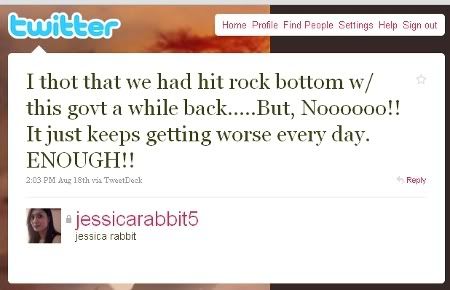The Gravity of Fear
Technorati tags: Fear, Gravity, Politics, MyConstitution, PerlembagaanKu
Some weeks back, Walski wrote a post about how low we’ve descended into the realms of bigotry, self-loathing, and plain old fear-mongering.
The inspiration for this post all began with something very simple – a tweet from one of Walski’s Twitter friends, @jessicarabbit5, about 3 weeks ago or so. Essentially, she was lamenting how she thought we’d reached rock bottom (with this government, specifically), but we seem to be getting worse every day.
Because he procrastinated on getting this post out, Walski honestly can’t remember what triggered @jessicarabbit5’s lament specifically. But in general, it’s about the depths we have descended, collectively as a nation, into the deep dark hole of despair. Generally speaking, it is also about the many people (Walski included) who are really sick and tired of the non-stop politicking of anything and everything that can be politicized – even charitable mosque visits.
And @jessicarabit5’s tweet inspired a thought that laid the foundation for Walski’s reply, in the form of an observation: “Doom can have a gravity field of its own. Hence, the deeper u go down the well of oblivion, the harder it is to get out”.
It’s kind of like depression, if you think about it. The longer one suffers from it, the more difficult it will be to rid oneself of it. And trust Walski on this one – he’s suffered from clinical depression before, and lifting one’s self out of personal gloom and doom mode isn’t easy.
In the case of Walski’s depression, it took a whole lot of wanting to get better, plus love and support from his friends.
When it comes to being depressed about Malaysia – and there is a lot to be depressed about – it will take a massive collective will to fight the cancerous influences of negativity surrounding us.
But just like clinical depression, the first step towards recovery is to recognize and admit that there is a problem. Remaining in denial doesn’t help one single bit.
(the gravitational forces of fear, and more, in the full post)
Perhaps the most obvious, and vocal, influence of negativity comes from the various rights groups that have sprouted like mushrooms post-March 2008. Most notable among these would, of course, be Perkasa.
From an observer’s viewpoint, groups such as Perkasa (and their various associates) have an impact on public policy, whether or not such an impact is admitted to by the policy makers. The most glaring impact has been on how proposed reform measures seem to not move as quickly as we think they should move. Worse, the impression that to appease the likes of Perkasa, the bold reforms planned are retracted or watered down.
For example, the New Economic Model (NEM) that was announced by the Prime Minister earlier this year was almost immediately attacked by Perkasa as not being in line with their agenda for Malay rights, even going as far as saying that these measures would be unconstitutional. Even though the details of the NEM weren’t, at the time, really clear to anyone.
Is Perkasa championing a situation where Malaysians can not be equal citizens by virtue of citizenship alone?
It makes one really wonder what kind of 1Malaysia Ibrahim Ali and Perkasa have in mind. And that got Walski thinking: exactly what makes organizations like Perkasa tick?
He took the thought one step further and started to analyze the various police reports and rhetorical pronouncements that have come from Perkasa and their associated organizations, such as MPM (Majlis Perundingan NGO Melayu – or Malay NGO Consultative Council). More recently there was Kelab Belia Graduan 1Malaysia (1Malaysia Youth Graduates Club – the group that filed a police report against the MyConstitution campaign for being “seditious”). Granted that KGB1M is not associated with Perkasa per se, certain thought processes seem to follow the same vein.
In Walski’s assessment, the root cause for the emergence and influence of these bodies can be distilled down to one basic human characteristic – fear. In this case, the fear of change.
Ibrahim Ali mentioned Article 153 of the Federal Constitution in the video clip above. This article is frequently quoted by Perkasa and various Malay rights advocates. What is not usually mentioned is that Article 153 does not stand in isolation, and in fact, references other provisions of the constitution. Plus, what Ibrahim Ali mentions (with regards to scholarships, etc.) is as a consequence of Article 153 and whose quantums are not explicitly enumerated.
 In this context, let’s look at the opposition to the MyConstitution campaign a little closer. It started sometime in mid-August with a rather cryptic report quoting Perak state mufti Harussani Zakaria claiming that a “new constitution” was being promoted by certain folks (via The Nut Graph).
In this context, let’s look at the opposition to the MyConstitution campaign a little closer. It started sometime in mid-August with a rather cryptic report quoting Perak state mufti Harussani Zakaria claiming that a “new constitution” was being promoted by certain folks (via The Nut Graph).
It didn’t help that Harussani refused to reveal his source. This pretty much opened him up to being accused of fear-mongering.
Then, Utusan perpetuated Harussani’s fear by publishing an editorial piece entitled “Benar, 'perang besar' boleh berlaku di Malaysia" (True, a 'big war' could happen in Malaysia) a day or so later, followed up by another piece “Perlembagaan digugat?” (Constitution threatened?) (note: both links are PDF files).
Not long after that Angin Perubahan, a pro-UMNO blog, presented “proof” of this alternate constitution. Turns out, the so-called proof was Fahmi Reza’s 2008 documentary, “10 Tahun Sebelum Merdeka”. Specifically, it made reference to a portion of the documentary where the People’s Constitution (Perlembagaan Rakyat), proposed by the AMCJA in 1947, was compared to the Federal Constitution.
Walski honestly didn’t know whether to laugh or cry when he stumbled upon the blog post. And then, of course, the police report made by KBG1M.
But the online attacks on the MyConstitution campaign didn’t stop with the posting mentioned above. Instead, it’s been taken up further by UMNO’s Unit Media Baru (UMB), headed by UMNO Youth Exco Member Tun Faisal Ismail bin Aziz.
UMB was set up as a cyber voice to speak on behalf of UMNO. It’s style, however, is not much different from many sensationalist pro-UMNO blogs.
So, why the accusation against the MyConstitution campaign of being seditious, when the intent is to educate the general public on what the Federal Constitution is (and isn’t), and what it allows for (and doesn’t)?
Walski thinks it’s fear. And it’s a fear on several levels – the fear that the people will know too much and realize that much Perkasa’s rhetoric is hogwash, which in turn feeds their fear of UMNO losing political power, and which conjures up the fears of being sidelined even more from an economic standpoint.
When trying to overcome clinical depression, after admitting that there is a problem, the road to recovery requires a conducive environment. In Walski’s case, as he’s mentioned previously, it was the love and support of those who cared enough for him.
How does one overcome fear? One of the often stated methods is to face it. It doesn’t help, however, when one’s environment goes out of the way to reinforce those fears. The end result is usually a case where the reinforcement feeds your fears to the point that even the mere mention of said fears evokes mind-killing emotions.
In the case of what the Malays apparently fear, this reinforcement comes, among others, in the form of one elder statesman named Dr. Mahathir Mohamed, who is, for all practical purposes, Perkasa’s patron saint. Dr. M may have done a lot of good for the nation during his tenure as Prime Minister, but being Perkasa’s cheerleader isn’t helping one iota.
Why? Simply put, what Dr. M has been saying of late legitimizes Perkasa’s methods of “upholding” Malay rights. These methods involve attempted suppression of views and opinions contrary to their own worldview. For example, in 2010 alone, no less than 20 different police reports have been filed by Perkasa to-date against a whole host of folks. Most of these were for articles or speech which offended their sensibilities. It’s almost as if Perkasa can say and do pretty much whatever they like, but the same cannot apply to others.
 But can the suppression of views eradicate their fears? Walski thinks not. In fact, suppression of contrarian viewpoints does the opposite, and instead reinforces those fears. In addition, suppression also reinforces the fear sufferers’ denial by sweeping problems under the carpet. Not good, all told.
But can the suppression of views eradicate their fears? Walski thinks not. In fact, suppression of contrarian viewpoints does the opposite, and instead reinforces those fears. In addition, suppression also reinforces the fear sufferers’ denial by sweeping problems under the carpet. Not good, all told.
It’s human nature to opt for choices deemed easier. Not doing anything about depression is easy. Same thing with fears. But what’s the real cost of inaction and doing nothing?
The feeling of doom and helplessness, as Walski mentioned early in the post, has a gravity field of its own. Not doing anything about these fears means that you allow them to fester and take over your psyche, making them more difficult to address as time goes by. But to start doing something about it, one has to admit that a problem exists.
Franklin D. Roosevelt once said that “there’s nothing to fear, but fear itself”. Meanwhile, on a faraway fictional universe, the powerful social order of the Bene Geserit recite this incantation in times of danger:
I must not fear.
Fear is the mind-killer.
Fear is the little-death that brings total obliteration.
I will face my fear.
I will permit it to pass over me and through me.
And when it has gone past I will turn the inner eye to see its path.
Where the fear has gone there will be nothing.
Only I will remain.
(source: Dune by Frank Hebert, via Wikipedia)
Perhaps it’s time to face whatever fears we perceive, before its powerful gravitational sucks us in even deeper into the well of oblivion. Because once we’ve transferred ourselves into the clutches of oblivion’s even stronger gravity field, escape will be something that we may only be able to dream of.

















